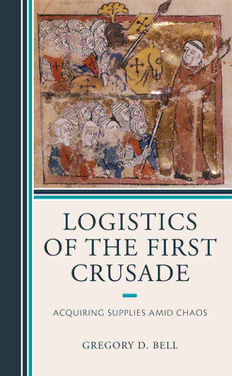
Logistics of the First Crusade: Acquiring Supplies Amid Chaos PDF
Preview Logistics of the First Crusade: Acquiring Supplies Amid Chaos
Logistics of the First Crusade Logistics of the First Crusade Acquiring Supplies Amid Chaos Gregory D. Bell LEXINGTONBOOKS Lanham•Boulder•NewYork•London PublishedbyLexingtonBooks AnimprintofTheRowman&LittlefieldPublishingGroup,Inc. 4501ForbesBoulevard,Suite200,Lanham,Maryland20706 wwwrowman.com 6TinworthStreet,LondonSE115AL Copyright©2020byTheRowman&LittlefieldPublishingGroup,Inc. Allrightsreserved.Nopartofthisbookmaybereproducedinanyformorbyany electronicormechanicalmeans,includinginformationstorageandretrievalsystems, withoutwrittenpermissionfromthepublisher,exceptbyareviewerwhomayquote passagesinareview. BritishLibraryCataloguinginPublicationInformationAvailable LibraryofCongressCataloging-in-PublicationDataAvailable LibraryofCongressControlNumber:2019950371 ISBN:978-1-4985-8640-5(cloth:alk.paper) ISBN:978-1-4985-8641-2(electronic) TMThepaperusedinthispublicationmeetstheminimumrequirementsofAmerican NationalStandardforInformationSciencesPermanenceofPaperforPrintedLibrary Materials,ANSI/NISOZ39.48-1992. Table of Contents Acknowledgments vii Introduction ix PartI:EstablishingSupplyPractices 1 1 LogisticalPreparationsandImplementationinEurope 3 2 ControlledViolence 25 3 PilgrimsatNicaea 45 PartII:TheRoadtoAntioch 65 4 IntoAnatolia 67 5 ApproachingAntioch:VyingforControlonLandandat Sea 83 6 FeedingtheArmyatAntioch 103 7 TheSiegeofAntioch:SuccessthroughLogistics 121 PartIII:PickingUpthePieces 137 8 APilgrim’sProgress:BesiegedatAntioch 139 9 ContinuedDelaysandStrifeafterAntioch 149 10 SuccessatJerusalem:Food,Water,andSiegeEngines 163 Conclusion 179 Bibliography 183 Index 193 AbouttheAuthor 201 v Acknowledgments IwishtothankJosephShatzmiller,whofirstbroughttomyattentionthe importanceoflogistics tounderstanding thecrusadenarrative,andwho hasbeenasteadfastmentoranddearfriend.NumerousscholarsatDuke UniversityandtheUniversityofNorthCarolinaatChapelHillreadearly versions of this manuscript, and their comments and feedback were in- valuable. I would also like to thank the editors at Rowman & Littlefield and Lexington Books, who have done so much to help make this book possible. Eric Kuntzman and his former colleague, Brian Hill, brought everything together and were instrumental in moving this project for- ward. I appreciate the efforts of Brennan Knight and my proofreader, both of whom helped to clean up and shape the book, and Alexandra Rallo did a fine job completing the finishing touches. A number of indi- viduals, especially my blind-reviewer, read the full manuscript and of- fered earnest and thoughtful feedback that did much to improve this work.Overthepastdecade,myfather-in-law,KennethFriedman,edited different iterations and offered valuable insights and suggestions. Natu- rally,anyremainingerrorsaremyown.Manyoftheprimarydocuments used for this project, notably the cartularies, are quite rare, and yet ac- cessing them was an altogether pleasant task due to the generosity and assistance of the Institute of Historical Research, the Bodleian Library’s Special Collections at Oxford University, the British Library, and the CambridgeUniversityLibrary.Inaddition,I’dliketoexpressmydeepest gratitudetofamilyandfriendswhohavestoodbymeovertheyears,and tocolleaguesandstudentsatWinthropUniversity,especiallythoseinthe HistoryDepartment.ItisatWinthropUniversitywherethisprojectcame tofruition. I dedicate this book to my wife, Erika, and our children, Aidan and Brynn,whohavebeenaconstantsupportthroughoutthisprocess. vii Introduction She [Jerusalem] seeks therefore and desires to be liberated, and does notceasetoimploreyoutocometoheraid...Accordinglyundertake this journey for the remission of your sins, with the assurance of the imperishable glory of the kingdom of heaven . . . Let the rich aid the needy;andaccordingtotheirwealth, letthemtake with themexperi- encedsoldiers...Whoever,therefore,shalldetermineuponthis holy pilgrimageandshallmakehisvowtoGodtothateffectandshalloffer himself to Him as a living sacrifice, holy, acceptable unto God, shall wear the sign of the cross of the Lord on his forehead or on his breast...1 Thus,inNovember,1095CE,inClermont,France,PopeUrbanIIfamous- lycalledforanexpeditiontotheHolyLandtorecaptureJerusalemfrom Islam. The subsequent campaign would come to be known as the First Crusade, and it would be a defining moment for the larger crusade movement.AlthoughJerusalemhadbeeninMuslimhandsforcenturies, the Holy City lay on the other side of the Christian Byzantine Empire, whichhadrecentlysufferedamajordefeatatthehandsofraidingSeljuk Turks.Therefore,thetaskofremovingIslam’sthreattoByzantiumwasa prerequisite to success on the longer journey, and obviously difficult enough. Retaking the Holy City would require a stupendous additional effort. Nevertheless, exhorted by a determined and highly convincing pope, in the final years of the eleventh century people from across what hascometobecalledWesternEuropebegantoprepareforanexpedition toliberatetheHolyLand. The practical task of organizing the expedition was daunting. Not only did these crusaders have to prepare to confront fearsome Turks in AsiaMinor,buttheyalsointendedtocontinuedeepintoMuslimterrito- ry to liberate Jerusalem.2 Participants on the expedition would have to travelroughly1,800miles(approximatelythedistancefromParistoCon- stantinople),mainlyonfoot,justtogettotheborderbetweenByzantium and Islam, and then walk an additional 1,200 miles through Muslim- controlled territory to arrive at Jerusalem, where an arduous siege was foreseeable.3Additionally,nooneknewwhoorhowmanypeoplewould actually join the expedition. It quickly became apparent that the scope andcompositionofthecrusaderrankswouldgenerateamajorchallenge asindividualsfromstrikinglydiversesegmentsofthepopulationvolun- teered.TheyweresovariedthatPopeUrbanhadtoclarifythatonlyable- ix x Introduction bodiedmen—soldiers—shouldparticipate.Infact,allsegmentsofsociety joined in the expedition to Jerusalem: the church called for the move- ment;thesecularnobilityledthecharge;andthepeasantryfilledoutthe ranks. The elderly, women, and even children were all involved. People of different ethnicities, speaking diverse languages and wearing distinc- tive clothes, would all need somehow to work harmoniously, traveling together thousands of miles to accomplish their common and, in their mindsglorious,purpose. In1096, the crusaders set out on their fantastic march to Jerusalem, a journey fraught with the practical perils of walking through an ever- changingandofteninhospitableenvironment.Theywouldhavetocross numerous political boundaries, and navigate broad plains and huge mountains,rivers,andseasinclimatesthatsometimesposedharsh,risky obstacles.Someparticipantswoulddrowncrossingrivers.Otherswould die ofthirston arid Anatolian plains. Still others would succumb to dis- ease due to unpotable water or illnesses that they had never been ex- posed to before. Sometimes sickness would be prevalent because fatal- ities,pileduponbattlefieldsanddecayinginhotair,couldnotbequickly disposed of. Others, shivering on high, narrow mountain passes, would falltotheirdeaths.Althoughafewcrusadersprobablyknewinadvance aboutsomeofthechallengingsituationstheymightfacebasedonstories told by previous pilgrims and soldiers, for most this was a journey into theunknown. Giventhescopeoftheundertaking,theunfamiliarnatureofthetask, andthenumerousobstaclesthathadtobeovercome,nottomention the comprehensive diversity of the participants involved, a remarkable task laybeforethem.LookingatthelogisticsoftheFirstCrusade—thatisthe movement and supply of the participants of the expedition—provides much more specific insight into how the participants managed to orga- nize and march an enormous and diverse army thousands of miles into foreign, hostile territory and capture the well-fortified city of Jerusalem. Itismyhopethatinexamininglogisticswecanseparatethewheatfrom the chaff in order to determine what these first crusaders actually did. Afteryearsoftravel,violence,andhardship,thesurvivorsofthisincred- iblejourneysucceededincapturingJerusalem.Muchofthissuccesswas duetothefactthat,againstincredibleodds,theparticipantsoftheexpe- dition were able to feed and supply themselves over a long period and despitecontinuousadversity,andthenfieldanarmycapableofbesieging and conquering Jerusalem. This book looks at how they accomplished this. Examiningthelogisticsofhistoricmilitarycampaignsisamorerecent phenomenon in the academic community, and two of the earliest works on the subject both validated the importance of understanding military campaigns through the prism of logistics and generated academic inter- est in the topic. Donald Engels accomplished this in his study of the
